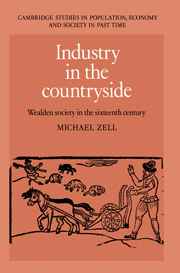Book contents
- Frontmatter
- Contents
- List of figures
- List of tables
- Acknowledgements
- List of abbreviation
- 1 Introduction
- 2 Landholding, inheritance and the local land market
- 3 Demographic movements, household structure and geographical mobility
- 4 The Wealden agrarian regime
- 5 Occupational structure and levels of wealth in the Weald
- 6 The textile industry in the Weald
- 7 Clothiers and capitalism
- 8 The Weald and ‘proto-industrialization’
- Bibliography
- Index
- Cambridge Studies in Population, Economy and Society in Past Time
4 - The Wealden agrarian regime
Published online by Cambridge University Press: 13 October 2009
- Frontmatter
- Contents
- List of figures
- List of tables
- Acknowledgements
- List of abbreviation
- 1 Introduction
- 2 Landholding, inheritance and the local land market
- 3 Demographic movements, household structure and geographical mobility
- 4 The Wealden agrarian regime
- 5 Occupational structure and levels of wealth in the Weald
- 6 The textile industry in the Weald
- 7 Clothiers and capitalism
- 8 The Weald and ‘proto-industrialization’
- Bibliography
- Index
- Cambridge Studies in Population, Economy and Society in Past Time
Summary
In every local region or pays in sixteenth-century England, even those areas characterized as ‘proto-industrial’, the basic industry was farming. The fundamental theme of this study is the link between agriculture and rural industry, and before it is possible to contemplate the nature of manufacturing in the Weald, the region's agrarian system must be examined. Not only did the agricultural regime of the Kent Weald antedate the arrival of clothmaking by at least several centuries, but, as will become obvious in later chapters, the bulk of the labour supply deployed by Wealden manufacturers and much of their capital depended on the region's farms. In recent decades historians have looked with increasing sophistication into the regional variations of British history. So historical geographers and agricultural historians have exposed the enormous variety in landscapes and in agricultural and tenurial structures to be found in early modern England. The most fundamental division between ‘highland’, wood-pasture regions on the one hand and lowland, ‘champion’ districts has been accepted for many years. Since the 1960s, and the publication of Thirsk's first early modern volume of The Agrarian History of England and Wales, numerous historians have set to work researching smaller areas within the broad upland and lowland divisions. Revision has proceeded apace and historians have pointed out the wide variation between different landscapes and agrarian systems within the two conventional zones, and suggested that the old classification into just two contrasting zones requires amendment.
- Type
- Chapter
- Information
- Industry in the CountrysideWealden Society in the Sixteenth Century, pp. 88 - 112Publisher: Cambridge University PressPrint publication year: 1994

